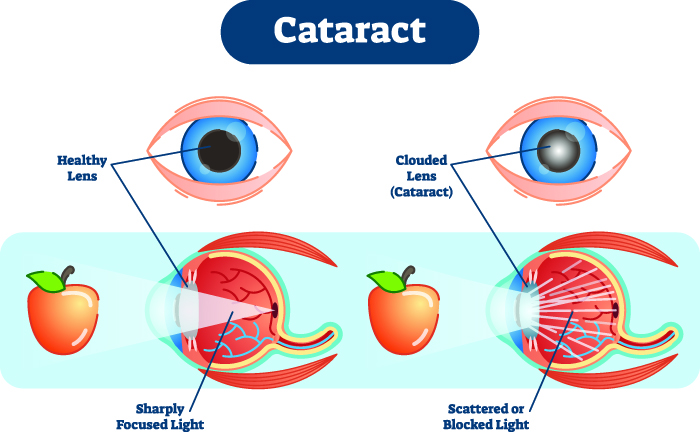Cataract Surgery in Chirag Enclave, Delhi
Cataracts usually refer to the opacity of the eye lenses. For people with cataracts, looking through muddy lenses is like looking out through an icy or foggy window. Cloudy vision caused by cataracts can make reading, driving (especially at night) or seeing facial expressions difficult.
If you have been diagnosed with cataract recently, you just need to search for an ophthalmology doctor near me or an ophthalmology hospital near me or ophthalmology doctors in Delhi.

What are the symptoms of cataracts?
Some of the common symptoms of cataracts are:
- Blurred vision
- Night vision problems
- Halo vision in light
- One eye can have double vision
- Colors loose intensity
- Loss of brightness in vision
- Sensitivity to the sun
- Change in eye prescription more frequently
What are the causes?
Most cataracts occur when aging or trauma changes the tissue in the lens of the eye. Certain genetic diseases that cause other health problems can increase your risk of cataracts. Cataracts can also be caused by other eye diseases, previous eye surgery or diseases such as diabetes. Long-term use of steroid drugs can also cause cataracts.
When do you need to see a doctor?
If you notice any changes in vision, please arrange for an eye consultation. If you have sudden vision problems, such as double vision or flashes, sudden eye pain or headache, see a doctor immediately.
Request an appointment at Apollo Spectra Hospitals, Chirag Enclave, New Delhi.
Call 1860 500 2244 to book an appointment.
Why is age a risk factor for cataracts?
As you age, the lens in your eyes becomes less flexible, opaque and thicker. Age-related diseases and other diseases can cause the tissues in the lens to break down and gather together, which can obscure small areas within the lens. The opacity becomes denser and covers most of the lens. Cataracts scatter and block light from passing through the lens, preventing clear images from reaching your retina. This will blur your vision.
Some of the other risk factors are:
- Increased blood glucose levels for years
- Prolonged sun exposure
- Being overweight or obese
- Habitual smoking
- Hypertension
- Inflammation or an injury to the eye
- Previous ophthalmic surgery
- Prolonged use of corticosteroid medications
- Alcohol abuse
How can this be treated?
Initially, you will be given prescription glasses for vision correction. However, after a point, you will need surgery as it will be the only treatment option remaining. You can consider some of the following lifestyle changes:
- Use brighter bulbs to enhance your home lighting.
- Make sure that your glasses or contact lenses have the most accurate prescription.
- If you need additional reading help, please use a magnifying glass.
- Use glare-reducing hat brim.
- Restrict driving at night.
You can search online for a cataract hospital near me, or a cataract specialist near me or cataract doctors near me.
Conclusion
Initially, the blurred vision caused by cataracts may only affect a small part of the lens of the eye, and you may not notice the decreased vision. As the cataract grows, it will further cover the lens and distort light passing through it. This may cause more obvious symptoms. So, the earlier you consult your ophthalmologist, the better it is for your eyes and your lifestyle.
References
https://www.mayoclinic.org/diseases-conditions/cataracts/symptoms-causes/syc-20353790
Most cataracts develop slowly and will not affect your vision at first, but over time, cataracts will eventually affect your vision.
Stronger lighting and glasses can help you deal with cataracts in the first place, but if your visual impairment interferes with your normal activities, you may need cataract surgery. Cataract surgery is a safe and effective surgery.
Both eyes usually get affected with cataracts. Cataracts in one eye can be more serious than the other eye, causing differences in vision between the eyes.
The lens where cataract is formed is located behind the colored part of the eye, called the iris. The lens focuses the light entering the eye and forms a clear and sharp image on the retina, which is the light-sensitive membrane of the eye, just like projection.
Symptoms
Our Doctors
DR. MRIDULA MEHTA
MBBS, MS - Ophthalmo...
| Experience | : | 22 Yeras Experience |
|---|---|---|
| Speciality | : | Ophthalmology... | Location | : | Chirag Enclave |
| Timings | : | Mon to Sat : 10:00 A... |
Our Top Specialities
NOTICE BOARD
CONTACT US
CONTACT US
 Book Appointment
Book Appointment



.svg)
.svg)
.svg)
.svg)








